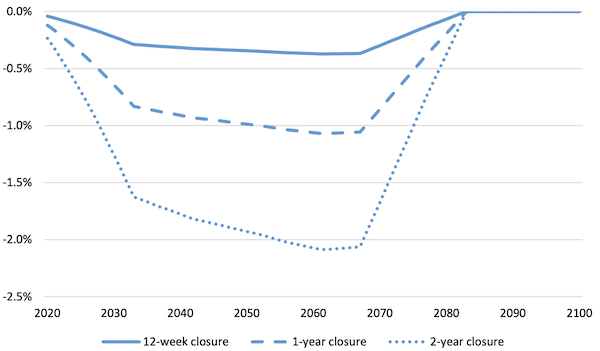By Christine de La Maisonneuve, Economist, Balázs Égert, Senior Economist Organisation for Economic Co-Operation and Development, Dave Turner, Head, Macroeconomic Analysis Division Organisation for Economic Co-Operation and Development. Originally published at VoxEU.
The COVID-19 pandemic led to the partial or full closure of schools in almost all countries around the world. On average, across OECD countries, school buildings were fully closed for 13 weeks and partially closed for a further 24 weeks between March 2020 and October 2021, which combined is equivalent to around one full school year. [1]. Learning losses stemming from school closure may be difficult to make up and so may have a long-term economic impact on the students affected, with possible enduring macroeconomic consequences (Ilzetzki 2020, Kuhn et al. 2020, Popova et al. 2020).
Figure 1 Duration of school closures between March 2020 and October 2021
Note: Full school closures refer to situations where all schools were closed nationwide due to COVID-19. Partial school closures refer to school closures in some regions or for some grades, or with reduced in-person instruction. Total closures are defined as the simple unweighted sum of these two aggregates.
Source: UNESCO.
We exploit a new measure of human capital, derived in Égert et al. (2022), that combines mean years of schooling (MYS) and OECD data from the Programme for International Student Assessment (PISA). The new measure is a cohort-weighted average of past PISA scores (representing the quality of education) of the working-age population and the corresponding mean years of schooling (representing the quantity of education). Weights for PISA scores and mean years of schooling are estimated from regressions which consider how well the cohort-weighted variables explain scores from the Programme of International Assessment of Adult Competencies (PIACC).
Based on this new measure, we can compute separately the effect of the pandemic on PISA scores and mean years of schooling (MYS) and feed this into the stock measure of human capital. For each cohort impacted, we add up the effects of the pandemic on MYS and PISA test scores to estimate the overall effect on human capital. We calculate these using the elasticities of MYS and PISA with respect to human capital, estimated in Égert et al. (2022). We then calculate a population-weighted average of the impact of each cohort affected to provide the global effect on human capital.
The new measure of human capital shows a robust correlation with productivity for OECD countries in cross-country time-series panel regressions. This helps us quantify the macroeconomic losses due to school closures, reflected in losses in PISA scores and mean years of schooling.
Using these estimates, we consider three scenarios:
- The effect of the spring 2020 school closures experienced in many OECD countries, which roughly corresponded to one-third of a school year closure. This period of closure translates into a -2.6% decrease in mean years of schooling[2] and, using the rule-of-thumb described above, a 0.14 standard deviation fall in PISA scores[3],corresponding to a 1.1% decrease in PISA scores.[4]
- The effect of a one-year school closure, broadly corresponding to the average total (full and partial) school closures observed across OECD countries since the start of the pandemic and, according to a first assessment, to the learning loss of the most disadvantaged students in the US (US Department of Education, 2022). This scenario translates into a -8.2% decrease in MYS and a -0.37 standard deviation fall in PISA scores, corresponding to a 2.9% decrease in PISA scores.
- The effect of a two-year school closure, which occurred only rarely and broadly corresponding to the total (full and partial) school closure in Colombia, Chile, Korea, and Mexico since the start of the pandemic which translates into a -16.5% decrease in MYS and a 5.6% and a -0.72 standard deviation fall in PISA scores
We estimate the impact of school closures on productivity through the human capital effect for these three scenarios. Multivariate productivity regressions link productivity to human capital in the presence of a number of control variables such as innovation intensity, product market regulation and trade openness. The impact will increase gradually as the student cohorts hit by the pandemic enter the labour force, reaching its peak in 2067. At that date, the impact of school closures on productivity will be -0.4%, -1.1% and -2.1% in the first, second and third scenarios, respectively. The impact will then dissipate gradually until the last impacted cohort retires in 2083 (Figure 2). The impact is largest in 2067, as this is when all the impacted cohorts will be in the older part of the labour force, and the impact on human capital is most important.
Figure 2 The impact of school closure on productivity

Source: Authors’ calculations.
Comparison with Estimates in the Existing Literature
The empirical findings of the literature standardised to a one-year school closure imply a non-negligible impact of the crisis on the level of GDP ranging from -1.1% to -4.7% around 2040-2050 (Dorn et al. 2020, Hanushek and Woessmann 2020, and Viana Costa et al. 2021). Researchers have used different methodologies. Dom et al. (2020) set up various scenarios to produce back-of-the-envelope calculations. Viana Costa et al. (2021) derive the economic costs using microsimulation model calculations. The calculations of Hanushek and Woessmann (2020) use macro regression analysis, which links GDP per capita to student test scores in a multi-country error-correction framework. Our results are broadly consistent with much of the literature except for Hanushek and Woessmann (2020), who found a much larger effect (-4.7%). Those results would be equivalent, ceteris paribus, for effect on GDP per capita.
Mitigation Policies
Mitigating the COVID-19 impact on human capital is a major policy challenge because most, if not all, education policy reforms have long implementation lags, implying that education policies mitigating the pandemic’s effect will not be able to reach the oldest student cohorts affected by COVID-19. An additional difficulty is that some policies concern the youngest students. Measures that could be implemented to help the catch up of affected student generations include the following (OECD 2020, OECD-Education International 2021, and Molato-Gayares et al. 2022):
- Extending the teaching time by temporarily reducing school holidays and/or adding hours in a school day.
- Revising the curriculum to focus on key skills.
- Providing teachers with training.
- Considering the use of digital technologies to improve the diagnosis of learning gaps and facilitate more individualised teaching practices
- Spreading collaboration and professional ways of working to increase teachers’ effectiveness
For the cohorts that have already left school, it is important to strengthen young adult training programmes. However, these are notoriously not very cost-effective, and offsetting losses in learning at younger ages can turn out to be very costly for the government budget.
Further measures could include extending and improving the quality of pre-school education, considered by many as the best value for money, which would come too late for almost all student cohorts affected by the pandemic. Other education policy reforms, which are found to have a positive correlation with student test scores during normal times, but which might also help offset some of the losses for the younger generations in the aftermath of the pandemic, include increased school accountability and school autonomy, reduced early tracking and improved teacher quality and qualifications.
[1] These average numbers hide large disparities across countries. While schools in Switzerland and Iceland were closed less than ten weeks, school closures in Korea, Chile and Colombia lasted nearly one and a half years (Figure 1). It is assumed that a full school year is 38 weeks.
[2] The percentage loss in MYS is calculated as the loss in schooling expressed in school years divided by the average MYS for the entire labour force. For example, for a loss of 0.32 school years assuming an average MYS for the entire labour force of 12 years implies a loss in MYS for that cohort of 2.6% (=0.32/12 x 100%).
[3] For 12 weeks, the fall in PISA score is equivalent to 0.14 (12*0.012) standard deviation; for one year, it is 0.37 (12*0.012+(38-12)*0.009) standard deviation and for two years it is 0.72 (12*0.012+(76-12)*0.009) standard deviation.
[4] Percentage loss in PISA = (Estimated impact * PISA standard deviation)/Base PISA score = (-.14 * 36.1)/462.
References available at the original.


